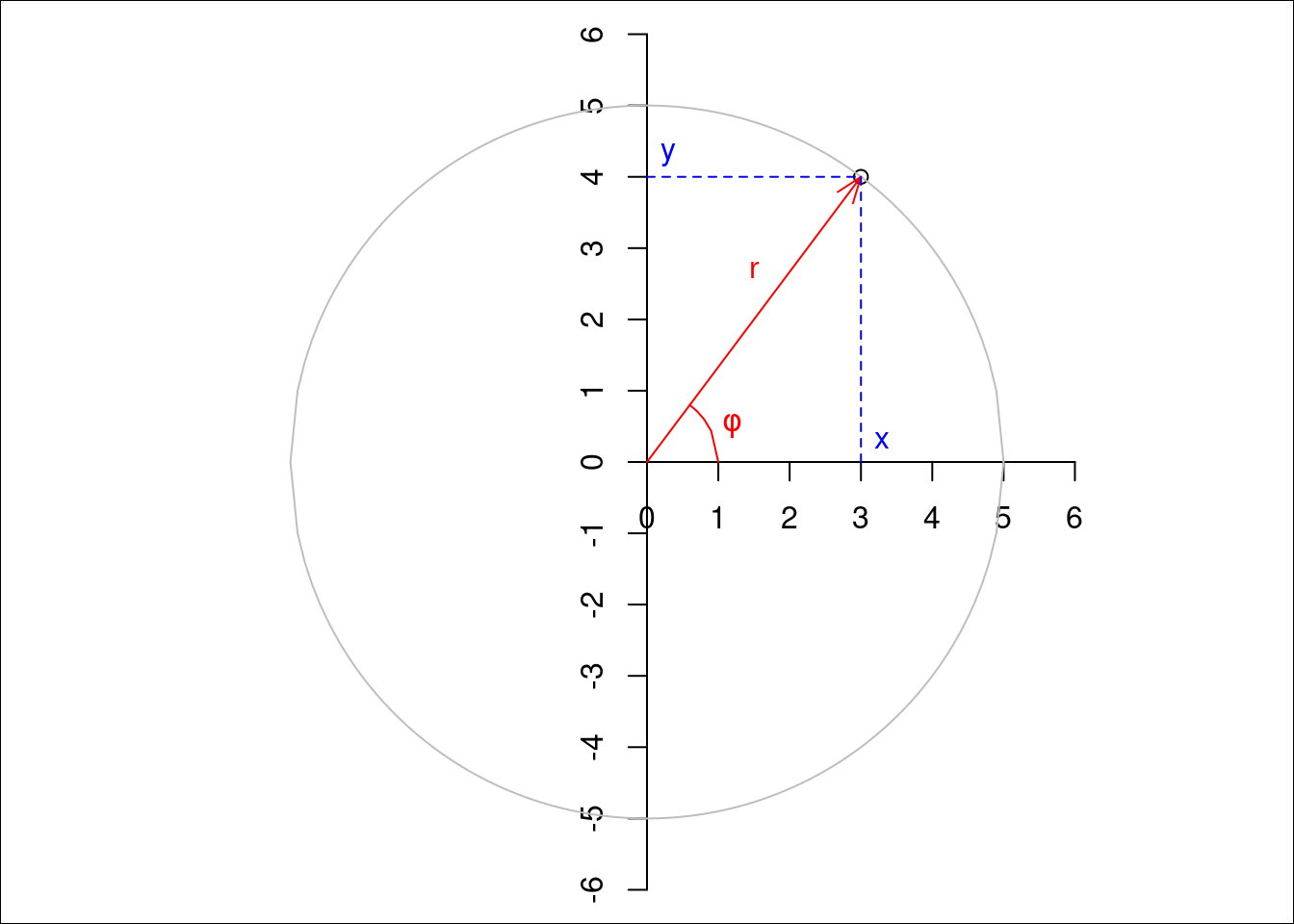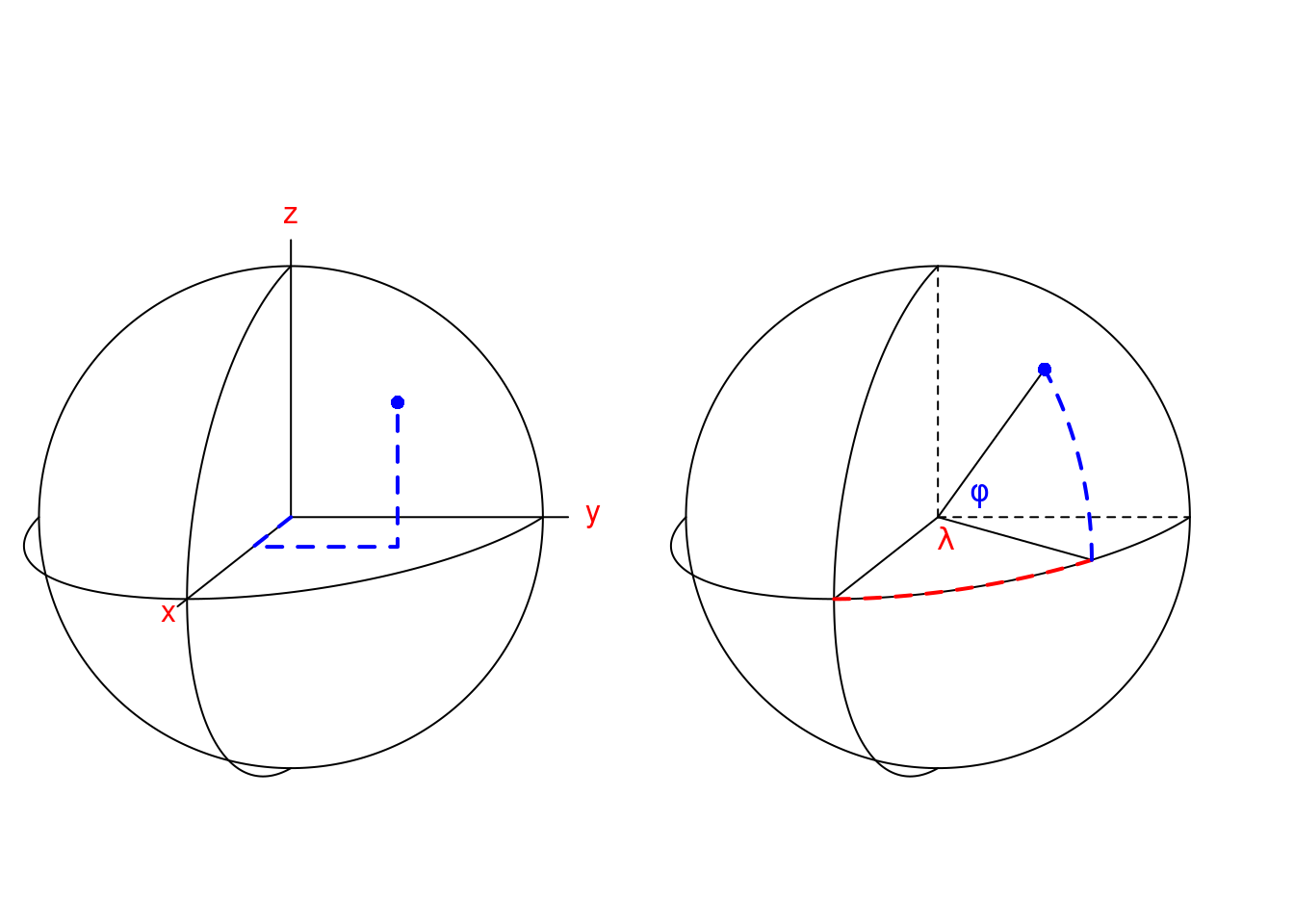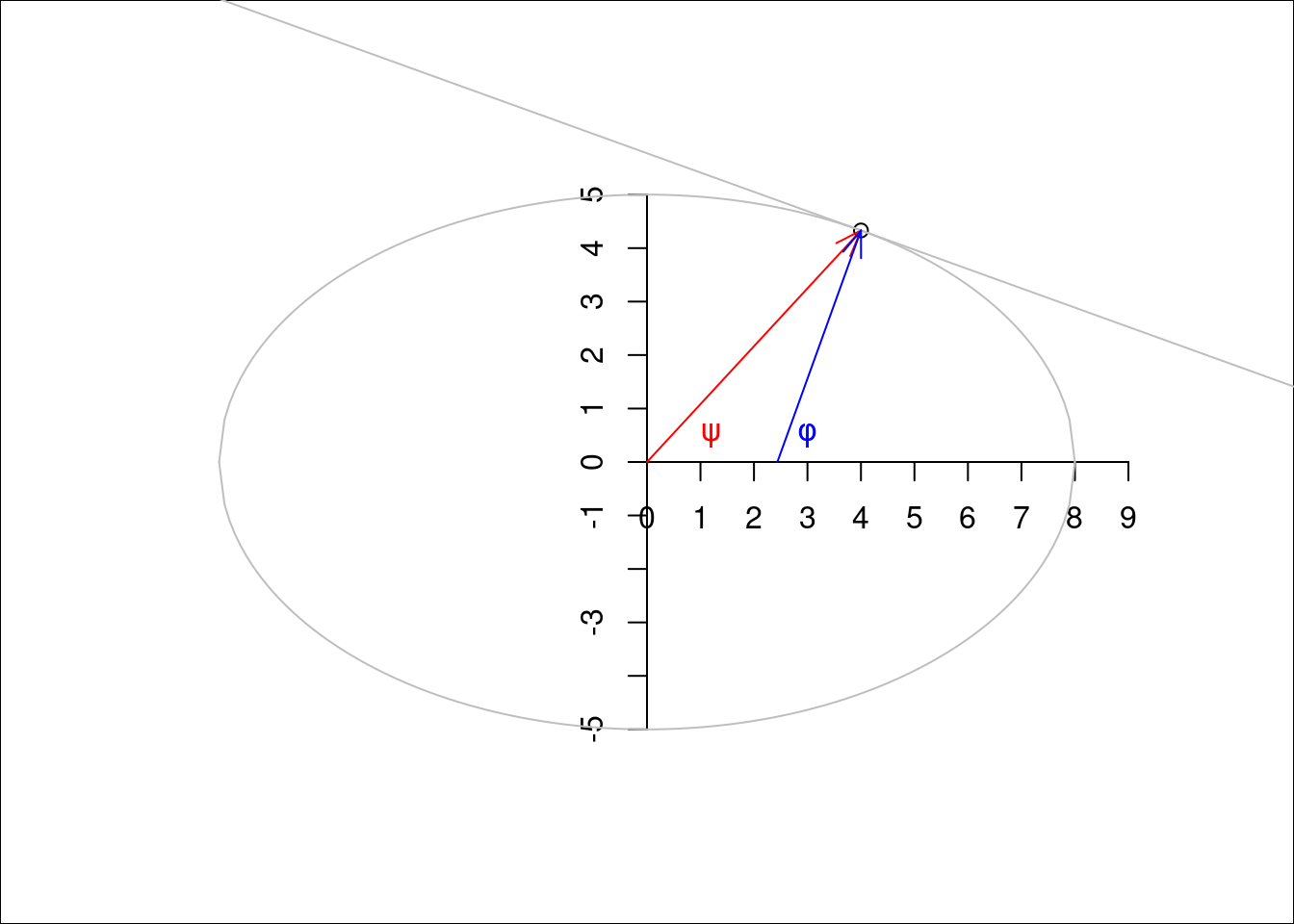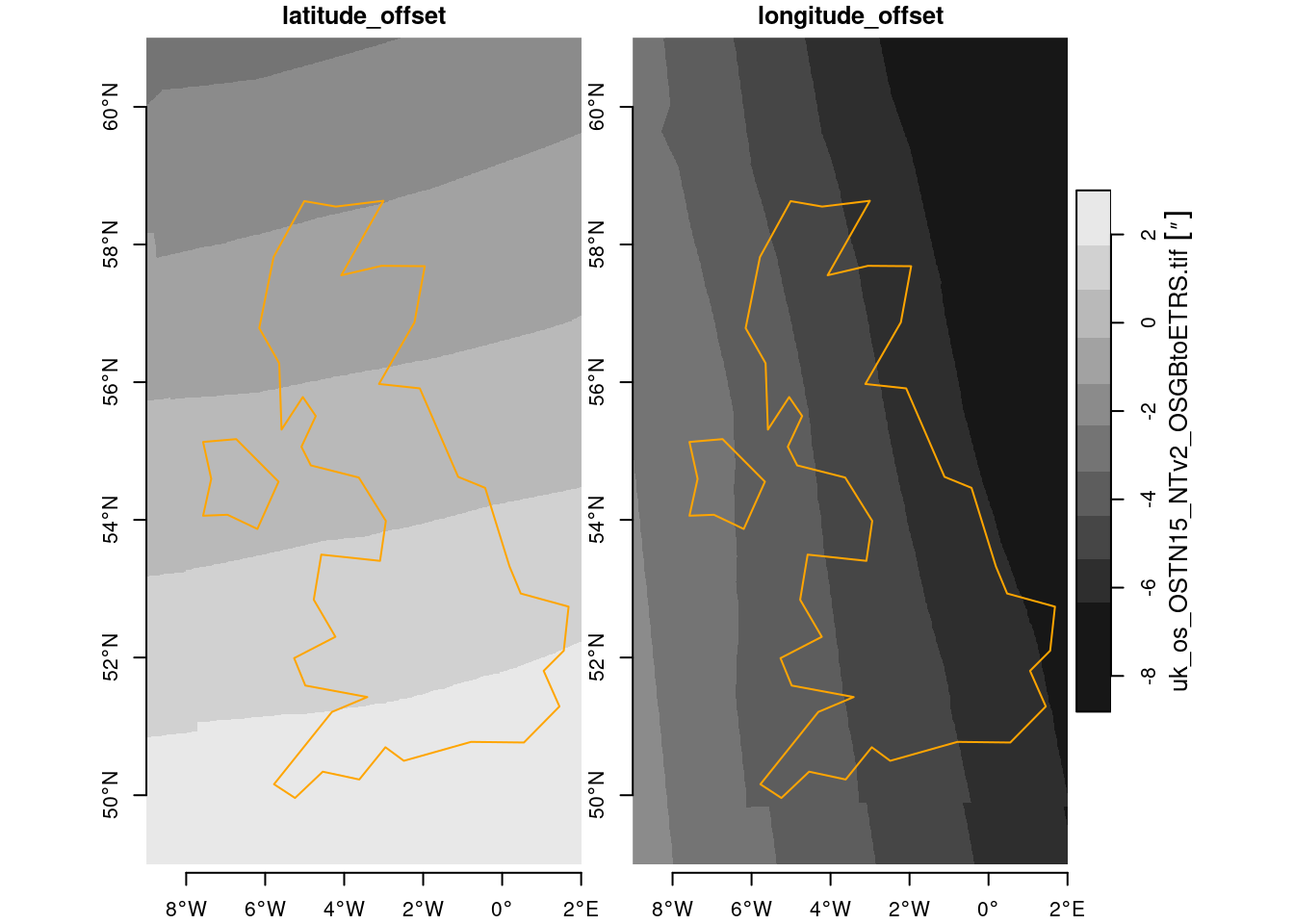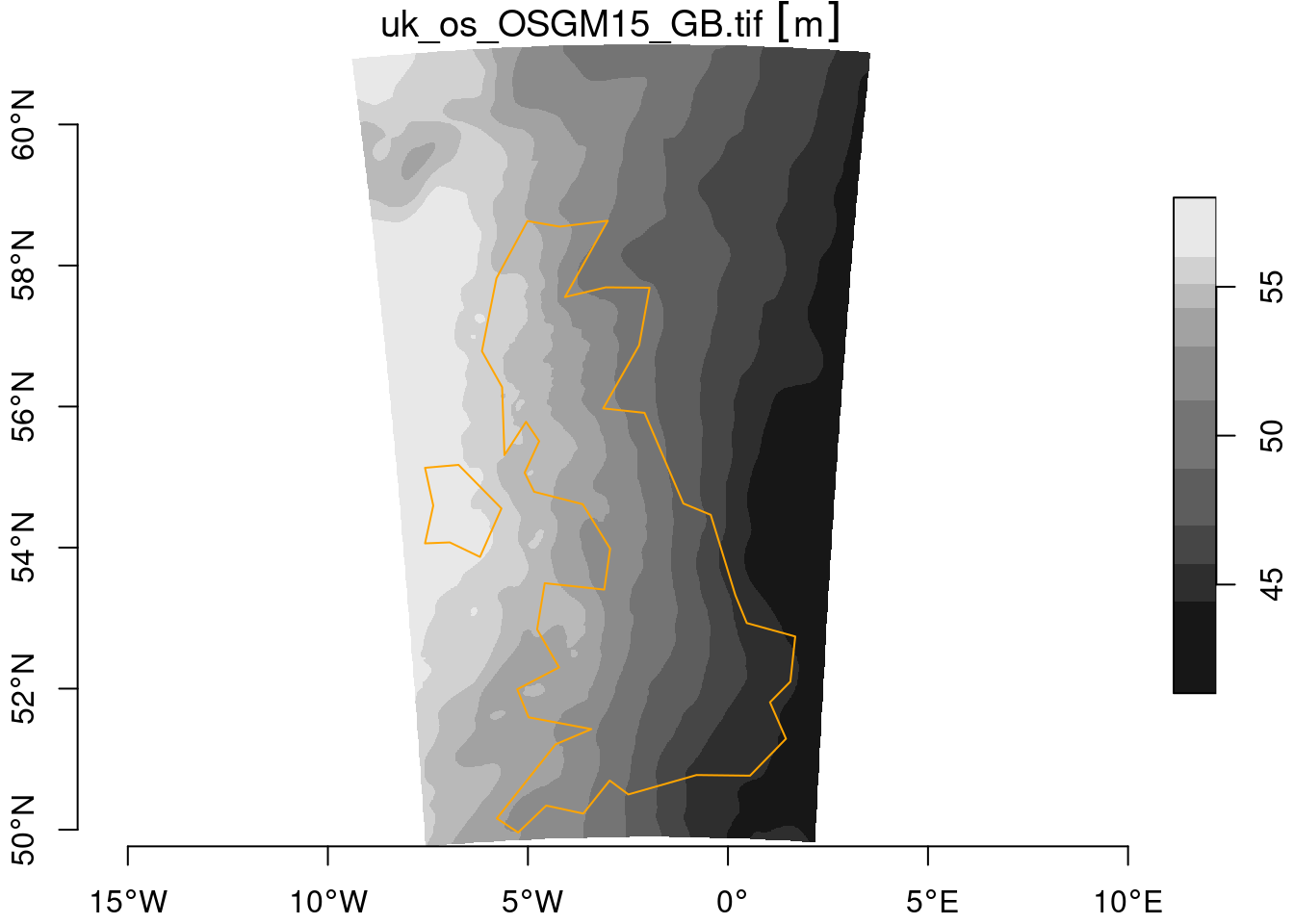# Coordinates {#sec-cs}
"_Data are not just numbers, they are numbers with a context_";
"_In data analysis, context provides meaning_" [@cobbmoore]
Before we can try to understand geometries like points, lines,
polygons, coverage and grids, it is useful to review coordinate
systems so that we have an idea what exactly coordinates of a
point reflect. For spatial data, the location of observations
are characterised by coordinates, and coordinates are defined in
a coordinate system. Different coordinate systems can be used for
this, and the most important difference is whether coordinates are
defined over a 2 dimensional or 3 dimensional space referenced
to orthogonal axes (Cartesian coordinates), or using distance
and directions (polar coordinates, spherical and ellipsoidal
coordinates). Besides a location of observation, all observations
are associated with time of observation, and so time coordinate
systems are also briefly discussed. First we will briefly review
_quantities_, to learn what units and datum are.
## Quantities, units, datum {#sec-units}
\index{quantities}
\index{units}
\index{measurement units}
The VIM ("International Vocabulary of Metrology", @vim)
defines a _quantity_ as a "property of a phenomenon, body, or
substance, where the property has a magnitude that can be expressed
as a number and a reference", where "[a] reference can be a measurement
unit, a measurement procedure, a reference material, or a combination
of such." Although one could argue about whether all data is
constituted of quantities, there is no need to argue that proper
data handling requires that numbers (or symbols) are accompanied
by information on what they mean, in particular what they refer to.
A measurement system consists of _base units_ for base quantities, and
_derived units_ for derived quantities. For instance, the SI system
of units [@SI] consists of seven base units: length (metre,
m), mass (kilogram, kg), time (second, s), electric current
(ampere, A), thermodynamic temperature (Kelvin, K), amount of
substance (mole, mol), and luminous intensity (candela, cd).
Derived units are composed of products of integer powers of base
units; examples are speed ($\mbox{m}~\mbox{s}^{-1}$), density
($\mbox{kg}~\mbox{m}^{-3}$) and area ($\mbox{m}^2$).
The special case of unitless measures can refer to either cases
where units cancel out (for instance mass fraction: kg/kg, or angle measured
in rad: m/m) or to cases where objects or events were counted
(such as "5 apples"). Adding an angle to a count of apples would not
make sense; adding 5 apples to 3 oranges may make sense if the
result is reinterpreted in terms of a superclass, in this case as _pieces of fruit_.
Many data variables have units that are not expressible as SI base
units or derived units. @hand discusses many such measurement scales,
including those used to measure variables like intelligence in
social sciences, in the context of measurement units.
For many quantities, the natural origin of values is zero. This
works for amounts, where differences between amounts result in
meaningful negative values. For locations and times, differences
have a natural zero interpretation: distance and duration. Absolute
location (position) and time need a fixed origin, from which we
can meaningfully measure other absolute space time points: we
call this **a datum**.
For space, a datum involves more than one dimension. The combination
of a datum and a measurement unit (scale) is a _reference system_.
\index{datum}
We will now elaborate how spatial locations can be expressed as
either ellipsoidal or Cartesian coordinates. The next sections will
deal with temporal and spatial reference systems, and how they are
handled in R.
## Ellipsoidal coordinates
```{r fig-polar, echo=!knitr::is_latex_output() }
#| out.width: 60%
#| fig.cap: "Two-dimensional polar (red) and Cartesian (blue) coordinates"
#| code-fold: true
par(mar = rep(0,4))
plot(3, 4, xlim = c(-6,6), ylim = c(-6,6), asp = 1)
axis(1, pos = 0, at = 0:6)
axis(2, pos = 0, at = -6:6)
xd <- seq(-5, 5, by = .1)
lines(xd, sqrt(25 - xd^2), col = 'grey')
lines(xd, -sqrt(25 - xd^2), col = 'grey')
arrows(0, 0, 3, 4, col = 'red', length = .15, angle = 20)
text(1.5, 2.7, label = "r", col = 'red')
xd <- seq(3/5, 1, by = .1)
lines(xd, sqrt(1 - xd^2), col = 'red')
text(1.2, 0.5, label = parse(text = "phi"), col = 'red')
lines(c(3,3), c(0,4), lty = 2, col = 'blue')
lines(c(0,3), c(4,4), lty = 2, col = 'blue')
text(3.3, 0.3, label = "x", col = 'blue')
text(0.3, 4.3, label = "y", col = 'blue')
```
@fig-polar shows both polar and Cartesian coordinates
for a two-dimensional situation. In Cartesian coordinates,
the point shown is $(x,y) = (3,4)$, for polar coordinates it is
$(r,\phi) = (5, \mbox{arctan}(4/3))$, where $\mbox{arctan}(4/3)$ is
approximately $0.93$ radians, or $53^{\circ}$. Note that $x$, $y$
and $r$ all have length units, where $\phi$ is an angle (a unitless
length/length ratio). Converting back and forth between Cartesian
and polar coordinates is trivial, as
$$x = r~\mbox{cos} \phi,\ \ \ y = r~\mbox{sin} \phi, \ \mbox{and}$$
$$r = \sqrt{x^2 + y^2}, \ \ \ \phi = \mbox{atan2}(y, x)$$
where $\mbox{atan2}$ is used in favour of $\mbox{atan}(y/x)$ to take care
of the right quadrant.
### Spherical or ellipsoidal coordinates
\index{ellipsoidal coordinates}
\index{coordinates!ellipsoidal}
\index{coordinates!geocentric}
\index{coordinates!Cartesian}
In three dimensions, where Cartesian coordinates are expressed as
$(x,y,z)$, spherical coordinates are the three-dimensional equivalent
of polar coordinates and can be expressed as $(r,\lambda,\phi)$, where:
* $r$ is the radius of the sphere,
* $\lambda$ is the longitude, measured in the $(x,y)$ plane counter-clockwise from positive $x$, and
* $\phi$ is the latitude, the angle between the vector and the $(x,y)$ plane.
@fig-sphere illustrates Cartesian geocentric and
ellipsoidal coordinates.
```{r fig-sphere, echo=!knitr::is_latex_output()}
#| fig.cap: "Cartesian geocentric coordinates (left) measure three distances, ellipsoidal coordinates (right) measure two angles, and possibly an ellipsoidal height"
#| code-fold: true
library(sf) |> suppressPackageStartupMessages()
e <- cbind(-90:90,0) # equator
f1 <- rbind(cbind(0, -90:90)) # 0/antimerid.
f2 <- rbind(cbind(90, -90:90), cbind(270, 90:-90))# +/- 90
eq <- st_sfc(st_linestring(e), st_linestring(f1), st_linestring(f2), crs='OGC:CRS84')
geoc <- st_transform(eq, "+proj=geocent")
cc <- rbind(geoc[[1]], NA, geoc[[2]], NA, geoc[[3]])
from3d <- function(x, offset, maxz, minz) {
x = x[,c(2,3,1)] + offset # move to y right, x up, z backw
x[,2] = x[,2] - maxz # shift y to left
d = maxz
z = x[,3] - minz + offset
x[,1] = x[,1] * (d/z)
x[,2] = x[,2] * (d/z)
x[,1:2]
}
maxz <- max(cc[,3], na.rm = TRUE)
minz <- min(cc[,3], na.rm = TRUE)
offset <- 3e7
circ <- from3d(cc, offset, maxz, minz)
mx <- max(cc, na.rm = TRUE) * 1.1
x <- rbind(c(0, 0, 0), c(mx, 0, 0))
y <- rbind(c(0, 0, 0), c(0, mx, 0))
z <- rbind(c(0, 0, 0), c(0, 0, mx))
ll <- rbind(x, NA, y, NA, z)
l0 <- from3d(ll, offset, maxz, minz)
mx <- max(cc, na.rm = TRUE) * 1.2
x <- rbind(c(0, 0, 0), c(mx, 0, 0))
y <- rbind(c(0, 0, 0), c(0, mx, 0))
z <- rbind(c(0, 0, 0), c(0, 0, mx))
ll <- rbind(x, NA, y, NA, z)
l <- from3d(ll, offset, maxz, minz)
par(mfrow = c(1, 2))
par(mar = rep(0,4))
plot.new()
plot.window(xlim = c(min(circ[,1],na.rm = TRUE), 3607103*1.02),
ylim = c(min(circ[,2],na.rm = TRUE), 2873898*1.1), asp = 1)
lines(circ)
lines(l0)
text(l[c(2,5,8),], labels = c("x", "y", "z"), col = 'red')
# add POINT(60 47)
p <- st_as_sfc("POINT(60 47)", crs = 'OGC:CRS84') |> st_transform("+proj=geocent")
p <- p[[1]]
pts <- rbind(c(0,0,0), c(p[1],0,0), c(p[1],p[2],0), c(p[1],p[2],p[2]))
ptsl <- from3d(pts, offset, maxz, minz)
lines(ptsl, col = 'blue', lty = 2, lwd = 2)
points(ptsl[4,1], ptsl[4,2], col = 'blue', cex = 1, pch = 16)
plot.new()
plot.window(xlim = c(min(circ[,1],na.rm = TRUE), 3607103*1.02),
ylim = c(min(circ[,2],na.rm = TRUE), 2873898*1.1), asp = 1)
lines(circ)
p <- st_as_sfc("POINT(60 47)", crs = 'OGC:CRS84') |> st_transform("+proj=geocent")
p <- p[[1]]
pts <- rbind(c(0,0,0), c(p[1],p[2],p[3]))
pt <- from3d(pts, offset, maxz, minz)
lines(pt)
points(pt[2,1], pt[2,2], col = 'blue', cex = 1, pch = 16)
p0 <- st_as_sfc("POINT(60 0)", crs = 'OGC:CRS84') |> st_transform("+proj=geocent")
p0 <- p0[[1]]
pts <- rbind(c(0,0,0), c(p0[1],p0[2],p0[3]))
pt <- from3d(pts, offset, maxz, minz)
lines(pt)
p0 <- st_as_sfc("POINT(0 0)", crs = 'OGC:CRS84') |> st_transform("+proj=geocent")
p0 <- p0[[1]]
pts <- rbind(c(0,0,0), c(p0[1],p0[2],p0[3]))
pt <- from3d(pts, offset, maxz, minz)
lines(pt)
p0 <- st_as_sfc("POINT(0 90)", crs = 'OGC:CRS84') |> st_transform("+proj=geocent")
p0 <- p0[[1]]
pts <- rbind(c(0,0,0), c(p0[1],p0[2],p0[3]))
pt <- from3d(pts, offset, maxz, minz)
lines(pt, lty = 2)
p0 <- st_as_sfc("POINT(90 0)", crs = 'OGC:CRS84') |> st_transform("+proj=geocent")
p0 <- p0[[1]]
pts <- rbind(c(0,0,0), c(p0[1],p0[2],p0[3]))
pt <- from3d(pts, offset, maxz, minz)
lines(pt, lty = 2)
f1 <- rbind(cbind(0:60, 0))
arc <- st_sfc(st_linestring(f1), crs='OGC:CRS84')
geoc <- st_transform(arc, "+proj=geocent")
cc <- rbind(geoc[[1]])
circ <- from3d(cc, offset, maxz, minz)
lines(circ, col = 'red', lwd = 2, lty = 2)
f1 <- rbind(cbind(60, 0:47))
arc <- st_sfc(st_linestring(f1), crs='OGC:CRS84')
geoc <- st_transform(arc, "+proj=geocent")
cc <- rbind(geoc[[1]])
circ <- from3d(cc, offset, maxz, minz)
lines(circ, col = 'blue', lwd = 2, lty = 2)
text(pt[1,1]+100000, pt[1,2]+50000, labels = expression(phi), col = 'blue') # lat
text(pt[1,1]+20000, pt[1,2]-50000, labels = expression(lambda), col = 'red') # lng
```
$\lambda$ typically varies between $-180^{\circ}$ and $180^{\circ}$
(or alternatively from $0^{\circ}$ to $360^{\circ}$), $\phi$ from
$-90^{\circ}$ to $90^{\circ}$. When we are only interested in points
_on_ a sphere with given radius, we can drop $r$: $(\lambda,\phi)$
now suffice to identify any point.
\newpage
It should be noted that this is just _a_ definition, one could for
instance also choose to measure polar angle, the angle between
the vector and $z$, instead of latitude. There is also a long
tradition of specifying points as $(\phi,\lambda)$ but throughout
this book we will stick to longitude-latitude, $(\lambda,\phi)$.
The point denoted in @fig-sphere has $(\lambda,\phi)$ or ellipsoidal
coordinates with angular values
```{r echo=!knitr::is_latex_output()}
#| code-fold: true
#| collapse: false
p <- st_as_sfc("POINT(60 47)", crs = 'OGC:CRS84')
p[[1]]
```
measured in degrees, and geocentric coordinates
```{r echo=!knitr::is_latex_output()}
#| code-fold: true
#| collapse: false
p <- st_as_sfc("POINT(60 47)", crs = 'OGC:CRS84') |> st_transform("+proj=geocent")
p[[1]]
```
measured in metres.
\index{coordinates!units}
For points on an ellipse, there are two ways in which angle can be
expressed (@fig-ellipse): measured from the centre of the ellipse
($\psi$), or measured perpendicular to the tangent on the ellipse
at the target point ($\phi$).
```{r fig-ellipse, echo=!knitr::is_latex_output() }
#| out.width: 60%
#| fig.cap: "Angles on an ellipse: geodetic (blue) and geocentric (red) latitude"
#| code-fold: true
par(mar = rep(0,4))
x <- 4
y <- 5/8 * sqrt(48)
plot(x, y, xlim = c(-6,6), ylim = c(-8,8), asp = 1)
axis(1, pos = 0, at = 0:9)
axis(2, pos = 0, at = -5:5)
xd <- seq(-8, 8, by = .1)
lines(xd, 5/8 * sqrt(64 - xd^2), col = 'grey')
lines(xd, 5/8 * -sqrt(64 - xd^2), col = 'grey')
arrows(0, 0, x, y, col = 'red', length = .15, angle = 20)
b <- (x * 25) / (-y * 64)
a <- y - x * b
abline(a, b, col = 'grey')
b <- -1/b
x0 <- x - y / b
arrows(x0, 0, x, y, col = 'blue', length = .15, angle = 20)
text(1.2, 0.5, label = parse(text = "psi"), col = 'red')
text(3, 0.5, label = parse(text = "phi"), col = 'blue')
```
The most commonly used parametric model for the Earth is _an
ellipsoid of revolution_, an ellipsoid with two equal semi-axes
[@iliffelott]. In effect, this is a flattened sphere (or spheroid):
the distance between the poles is (slightly: about 0.33%) smaller
than the distance between two opposite points on the equator. Under
this model, longitude is always measured along a circle (as in
@fig-sphere), and latitude along an ellipse (as in
@fig-ellipse). If we
think of @fig-ellipse as a cross section of the Earth
passing through the poles, the _geodetic_ latitude measure $\phi$
is the one used when no further specification is given. The latitude
measure $\psi$ is called the _geocentric latitude_.
\index{latitude!geodetic}
\index{latitude!geocentric}
\index{longitude}
\index{ellipsoid of revolution}
\index{altitude}
\index{altitude!direction}
\index{coordinates!altitude}
we can add _altitude_ or elevation to longitude and latitude to
define points that are above or below the ellipsoid, and obtain
a three-dimensional space again. When defining altitude, we need
to choose:
* where zero altitude is: on the ellipsoid, or relative to the surface approximating mean sea level (the geoid)?
* which direction is positive, and
* which direction is "straight up": perpendicular to the ellipsoid surface,
or in the direction of gravity, perpendicular to the surface of the geoid?
All these choices may matter, depending on the application area
and required measurement accuracies.
The shape of the Earth is not a perfect ellipsoid. As a consequence,
several ellipsoids with different shape parameters and bound to
the Earth in different ways are being used. Such ellipsoids are called
_datums_, and are briefly discussed in @sec-crs, along
with _coordinate reference systems_.
### Projected coordinates, distances {#sec-projections}
Because paper maps and computer screens are much more abundant
and practical than globes, when we look at spatial
data we see it _projected_: drawn on a flat, two-dimensional
surface. Computing the locations in a two-dimensional space means
that we work with _projected_ coordinates. Projecting ellipsoidal
coordinates means that shapes, directions, areas, or even all three,
are distorted [@iliffelott].
\index{coordinates!projected}
\index{projection}
\index{distance!straight line}
Distances between two points $p_i$ and $p_j$ in Cartesian coordinates are computed
as Euclidean distances, in two dimensions by
$$d_{ij} = \sqrt{(x_i-x_j)^2+(y_i-y_j)^2}$$
with $p_i = (x_i,y_i)$
and in three dimensions by
$$d_{ij} = \sqrt{(x_i-x_j)^2+(y_i-y_j)^2+(z_i-z_j)^2}$$
with $p_i = (x_i,y_i,z_i).$
These distances represent the length of a _straight_ line between
two points $i$ and $j$.
For two points on a circle, the length of the arc of two points $c_1 = (r,{\phi}_1)$ and
$c_2 = (r, \phi_2)$ is
$$s_{ij}=r~|\phi_1-\phi_2| = r ~\theta$$
with $\theta$ the angle between $\phi_1$ and $\phi_2$ in radians.
For very small values of $\theta$, we will have $s_{ij} \approx d_{ij}$,
because a small arc segment is nearly straight.
\index{distance!great circle}
For two points $p_1 = (\lambda_1,\phi_1)$ and $p_2 =
(\lambda_2,\phi_2)$ on a sphere with radius $r'$, the _great circle
distance_ is the arc length between $p_1$ and $p_2$ on the circle
that passes through $p_1$ and $p_2$ and has the centre of the sphere as its centre, and
is given by $s_{12} = r ~ \theta_{12}$ with
$$\theta_{12} = \arccos(\sin \phi_1 \cdot \sin \phi_2 + \cos \phi_1 \cdot \cos \phi_2 \cdot \cos(|\lambda_1-\lambda_2|))$$
the angle between $p_1$ and $p_2$, in radians.
Arc distances between two points on a spheroid are more complicated
to compute; a good discussion on the topic and an explanation of
the method implemented in GeographicLib (part of PROJ) is given
in @karney2013algorithms.
\index{distance!ellipsoidal}
To show that these distance measures actually give different
values, we computed them for the distance Berlin - Paris. Here,
`gc_` refers to ellipsoidal and spherical great circle distances,
`str_` refers to straight line, Euclidean distances between
Cartesian geocentric coordinates associated on the WGS84 ellipse
and sphere:
```{r echo=!knitr::is_latex_output(), message=FALSE}
#| code-fold: true
#| collapse: false
pts <- st_sfc(st_point(c(13.4050, 52.5200)), st_point(c(2.3522, 48.8566)), crs = 'OGC:CRS84')
s2_orig <- sf_use_s2(FALSE)
d1 <- c(gc_ellipse = st_distance(pts)[1,2])
sf_use_s2(TRUE)
# or, without using s2, use st_distance(st_transform(pts, "+proj=cart +ellps=sphere"))
d2 <- c(gc_sphere = st_distance(pts)[1,2])
p <- st_transform(pts, "+proj=cart +ellps=WGS84")
d3 <- c(str_ellipse = units::set_units(sqrt(sum(apply(do.call(cbind, p), 1, diff)^2)), m))
p2 <- st_transform(pts, "+proj=cart +ellps=sphere")
d4 <- c(str_sphere = units::set_units(sqrt(sum(apply(do.call(cbind, p2), 1, diff)^2)), m))
res <- c(d1, d3, d2, d4) # note order
# print as km, re-add names:
sf_use_s2(s2_orig) # back to what it was before changing
res |> units::set_units(km) |> setNames(names(res)) |> print(digits = 5)
```
### Bounded and unbounded spaces {#sec-bounded}
\index{sphere}
\index{space!bounded}
\index{space!unbounded}
Two-dimensional and three-dimensional Euclidean spaces ($R^2$ and
$R^3$) are unbounded. Every line in this space has infinite length,
and areas or volumes have no natural upper limit. In contrast,
spaces defined on a circle ($S^1$) or sphere ($S^2$) define a bounded
set: there may be infinitely many points but the length and area
of the circle, and the radius, area and volume of a sphere are bounded.
This may sound trivial but leads to some interesting challenges
when handling spatial data. A polygon on $R^2$ has unambiguously an
inside and an outside. On a sphere, $S^2$, any polygon divides
the sphere in two parts, and which of these two is to be considered
inside and which outside is ambiguous and needs to be defined
by the traversal direction. @sec-spherical will further discuss
consequences when working with geometries on $S^2$.
\index{polygon!on the sphere}
\index{polygon!inside, outside}
## Coordinate reference systems {#sec-crs}
\index{coordinate reference systems}
We follow @lott2015 when defining the following concepts (italics indicate literal quoting):
* a **coordinate system** is a _set of mathematical rules for specifying how coordinates are to be assigned to points_,
* a **datum** is a _parameter or set of parameters that define the position of the origin, the scale, and the orientation of a coordinate system_,
* a **geodetic datum** is a _datum describing the relationship of a two- or three-dimensional coordinate system to the Earth_, and
* a **coordinate reference system** is a _coordinate system that is related to an object by a datum; for geodetic and vertical datums, the object will be the Earth._
\index{coordinate system}
\index{geodetic datum}
A readable text that further explains these concepts is @iliffelott.
The Earth does not follow a regular shape. The topography of the
Earth is of course known to vary strongly, but also the surface
formed by constant gravity at mean sea level, the geoid, is
irregular. A commonly used model that is fit to the geoid is an
ellipsoid of revolution, which is an ellipsoid with two identical
minor axes. Fitting such an ellipsoid to the Earth gives a datum.
However, fitting it to different areas, or based on different sets of
reference points gives different fits, and hence different datums:
a datum can for instance be fixed to a particular tectonic plate
(like the European Terrestrial Reference System 1989 (ETRS89)), others can be globally fit (like WGS84). More local
fits lead to smaller approximation errors.
\index{geoid}
The definitions above imply that coordinates in degrees longitude
and latitude only have a meaning and can only be interpreted
unambiguously as Earth coordinates, when the datum they are
associated with is given.
Note that for projected data, the data that _were_ projected
are associated with a reference ellipsoid (datum). Going from
one projection to another _without_ changing datum is called
_coordinate conversion_, and passes through the ellipsoidal
coordinates associated with the datum involved. This process is
lossless and invertible: the parameters and equations associated
with a _conversion_ are not empirical. Recomputing coordinates in a
new datum is called _coordinate transformation_, and is approximate:
because datums are a result of model fitting, transformations
between datums are models too that have been fit; the equations
involved are empirical, and multiple transformation paths, based
on different model fits and associated with different accuracies,
are possible.
\index{coordinate!conversion}
\index{coordinate!transformation}
Plate tectonics imply that within a global datum, fixed objects may
have coordinates that change over time, and that transformations
from one datum to another may be time-dependent. Earthquakes are a
cause of more local and sudden changes in coordinates. Local datums
may be fixed to tectonic plates (such as ETRS89), or may be dynamic.
\index{datum!dynamic}
## PROJ and mapping accuracy {#sec-projlib}
Very few living people active in open source geospatial software
can remember the time before PROJ. PROJ [@evenden:90] started in the
1970s as a Fortran project, and was released in 1985 as a C library
for cartographic projections. It came with command line tools for
direct and inverse projections, and could be linked to software
to let it support (re)projection directly. Originally, datums were
considered implicit, and no datum transformations were allowed.
\index{PROJ}
\index{PROJ!PROJ.4}
\index{PROJ!proj4string}
In the early 2000s, PROJ was known as PROJ.4, after its never-changing
major version number. Amongst others motivated by the rise of GPS,
the need for datum transformations increased and PROJ.4 was extended
with rudimentary datum support. PROJ definitions for coordinate
reference systems would look like this:
```
+proj=utm +zone=33 +datum=WGS84 +units=m +no_defs
```
where _key_=_value_ pairs are preceded by a `+` and separated by
a space. This form came to be known as "PROJ.4 string", since the
PROJ project stayed at version 4.x for several decades. Other datums
would come with fields like:
```
+ellps=bessel +towgs84=565.4,50.3,465.6,-0.399,0.344,-1.877,4.072
```
indicating another ellipse, as well as the seven (or three)
parameters for transforming from this ellipse to WGS84 (the "World
Geodetic System 1984" global datum once popularised by GPS),
effectively defining the datum in terms of a transformation to WGS84.
Along with PROJ.4 came a set of databases with known (registered)
projections, from which the best known is the European Petroleum Survey Group (EPSG) registry.
National mapping agencies would provide (and update over time)
their best guesses of `+towgs84` parameters for national coordinate
reference systems, and distribute through the EPSG registry,
which was part of PROJ distributions.
For some transformations, _datum grids_ were available and
distributed as part of PROJ.4: such grids are raster maps that provide
for every location pre-computed values for the shift in longitude
and latitude, or elevation, for a particular datum transformation.
In PROJ.4, every coordinate transformation had to go through a
conversion to and from WGS84; even reprojecting data associated with
a datum different from WGS84 had to go through a transformation to
and from WGS84. The associated errors of up to 100 m were acceptable
for mapping purposes for not too small areas, but some applications
need higher accuracy transformations. Examples include precision
agriculture, planning flights of UAV's, or object tracking.
In 2018, after a successful "GDAL Coordinate System Barn Raising"
initiative, a number of companies profiting from the open source
geospatial software stack supported the development of a more modern,
mature coordinate transformation system in PROJ. Over a few years,
PROJ.4 evolved through versions 5, 6, 7, 8 and 9 and was hence renamed
into PROJ (or PR$\phi$J).
\index{GDAL!barn raising}
\index{GDAL!datum transformation}
\index{PROJ!datum transformation}
The most notable changes include:
* although PROJ.4 strings can still be used to initialise certain
coordinate reference systems, they are no longer sufficient to
represent all of them; a new format, WKT-2 (described in next section)
replaces it
* WGS84 as a hub datum is dropped: coordinate transformations no longer
need to go through a particular datum
* multiple conversion or transformation paths (so-called pipelines)
to go from CRS A to CRS B are possible, and can be reported along
with the associated accuracy; PROJ will by default use the most accurate
one but user control is possible
* transformation pipelines can chain an arbitrary number of
elementary transformation operations, including swapping of axes
and unit transformations
* datum grids, of which there are now _many_ more, are no longer distributed
with the library but are accessible from a content delivery network (CDN); PROJ allows enabling and
disabling network access to these grids and only downloads the section(s)
of the grid actually needed, storing it in a cache on the user's machine for
future use
* coordinate transformations receive support for epochs, time-dependent
transformations (and hence: four-dimensional coordinates, including the
source and target time)
* the set of files with registered coordinate reference systems is handled
in an SQLite database
* instead of always handling axis order (longitude, latitude),
when the authority defines differently this is now obeyed (but see
@sec-wkt2 and @sec-axisorder)
\index{WKT-2}
\index{PROJ!WKT-2}
\index{projection!accuracy}
All these points sound like massive improvements, and accuracies
of transformation can be below 1 metre. An interesting point
is the last: Where we could safely assume for many decades that
spatial data with ellipsoidal coordinates would have axis order
(longitude, latitude), this is no longer the case. We will see in
@sec-axisorder how to deal with this.
\index{datum!grids}
```{r fig-horizontalgrid, echo=!knitr::is_latex_output(), message = FALSE}
#| out.width: 70%
#| fig.cap: "UK horizontal datum grid, from datum OSGB 1936 (EPSG:4277) to datum ETRS89 (EPSG:4258); units arc-seconds"
#| code-fold: true
library(stars)
library(rnaturalearth)
library(dplyr) |> suppressPackageStartupMessages()
countries110 |>
st_as_sf() |>
filter(ADMIN == "United Kingdom") |>
st_geometry() -> uk
filename = "data/uk_os_OSTN15_NTv2_OSGBtoETRS.tif"
r <- if (file.exists(filename)) {
r <- read_stars(filename)
} else {
read_stars("/vsicurl/https://cdn.proj.org/uk_os_OSTN15_NTv2_OSGBtoETRS.tif")
}
hook <- function() {
plot(uk, border = "orange", col = NA, add = TRUE)
}
plot(r[,,,1:2], axes = TRUE, hook = hook, key.pos = 4)
```
```{r fig-verticalgrid, echo=!knitr::is_latex_output(), message = FALSE}
#| out.width: 70%
#| fig.cap: "UK vertical datum grid, from ETRS89 (EPSG:4937) to ODN height (EPSG:5701), units m"
#| code-fold: true
filename = "data/uk_os_OSGM15_GB.tif"
h <- if (file.exists(filename)) {
read_stars(filename)
} else {
read_stars("/vsicurl/https://cdn.proj.org/uk_os_OSGM15_GB.tif")
}
plot(h, axes = TRUE, reset = FALSE)
plot(uk, border = "orange", col = NA, add = TRUE)
```
\index{coordinates!axis order}
\index{axis order}
Examples of a horizontal datum grids, downloaded from cdn.proj.org,
are shown in @fig-horizontalgrid and for a vertical
datum grid in @fig-verticalgrid. Datum grids may carry
per-pixel accuracy values.
## WKT-2 {#sec-wkt2}
@lott2015 describes a standard for encoding coordinate reference
systems, as well as transformations between them using _well-known text_;
the standard (and format) is referred to informally as
WKT-2. As mentioned above, GDAL and PROJ fully support this encoding.
An example of WKT-2 for CRS `EPSG:4326` is:
\index{coordinates!WKT-2}
\index{WKT-2}
```
GEOGCRS["WGS 84",
ENSEMBLE["World Geodetic System 1984 ensemble",
MEMBER["World Geodetic System 1984 (Transit)"],
MEMBER["World Geodetic System 1984 (G730)"],
MEMBER["World Geodetic System 1984 (G873)"],
MEMBER["World Geodetic System 1984 (G1150)"],
MEMBER["World Geodetic System 1984 (G1674)"],
MEMBER["World Geodetic System 1984 (G1762)"],
MEMBER["World Geodetic System 1984 (G2139)"],
ELLIPSOID["WGS 84",6378137,298.257223563,
LENGTHUNIT["metre",1]],
ENSEMBLEACCURACY[2.0]],
PRIMEM["Greenwich",0,
ANGLEUNIT["degree",0.0174532925199433]],
CS[ellipsoidal,2],
AXIS["geodetic latitude (Lat)",north,
ORDER[1],
ANGLEUNIT["degree",0.0174532925199433]],
AXIS["geodetic longitude (Lon)",east,
ORDER[2],
ANGLEUNIT["degree",0.0174532925199433]],
USAGE[
SCOPE["Horizontal component of 3D system."],
AREA["World."],
BBOX[-90,-180,90,180]],
ID["EPSG",4326]]
```
This shows a coordinate system with the axis order _latitude,
longitude_, although in most practical cases the axis order used is
_longitude, latitude_. The _ensemble_ of WGS84 ellipsoids listed
represents its various updates over time. Ambiguity about _which_
of these ensemble members a particular dataset should use leads to
an uncertainty of several meters. The coordinate reference system
`OGC:CRS84` disambiguates the axis order and explicitly states it
to be `longitude, latitude`, and is the recommended alternative to
WGS84 datasets using this axis order. It does not disambiguate
the datum ensemble problem.
\index{axis order!disambiguate}
\index{WGS84}
\index{OGC:CRS84}
A longer introduction on the history and recent changes in PROJ
is given in @rogerCRS, building upon the work of @knudsen+evers17
and @evers+knudsen17.
## Exercises
Try to solve the following exercises with R (without loading packages); try to use functions where appropriate:
1. list three _geographic_ measures that do not have a natural zero origin
<!-- latitude, longitude, elevation -->
2. convert the $(x,y)$ points $(10,2)$, $(-10,-2)$, $(10,-2)$, and $(0,10)$ to polar coordinates
3. convert the polar $(r,\phi)$ points $(10,45^{\circ})$, $(0,100^{\circ})$, and $(5,359^{\circ})$ to Cartesian coordinates
4. assuming the Earth is a sphere with a radius of 6371 km, compute for $(\lambda,\phi)$ points the great circle distance between $(10,10)$ and $(11,10)$, between $(10,80)$ and $(11,80)$, between $(10,10)$ and $(10,11)$, and between $(10,80)$ and $(10,81)$ (units: degree). What are the distance units?
